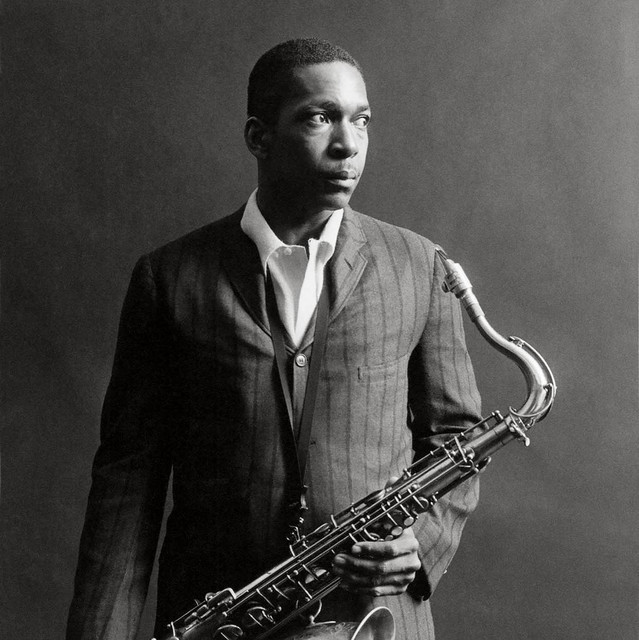Ars longa, vita brevis—“art is long, life is short.” John Coltrane’s life is one of the clearest testaments to that truth. Although he died at the young age of 40 with only 12 years of career, his influence has never diminished, even nearly 60 years after his death. Few dispute that Coltrane was the greatest jazz saxophonist the world has seen. As Miles Davis, one of the greatest musicians of all time, once said, “his music is what he left us, and we can all learn from that.”
Born on September 23, 1926, in Hamlet, North Carolina, John William Coltrane grew up listening to the popular songs at the peak of the swing era. He received his first saxophone, an alto, on his 17th birthday in 1943. Later, he joined the Navy and played in the Navy big band. After being discharged, he studied music theory with jazz guitarist and composer Dennis Sandole. When he first saw Charlie Parker perform in 1945, bebop captured his imagination. That moment drew him into the world of bebop, with its fast tempos, adventurous improvisation, and complex harmonies—forming the foundation of his early musical language.
Before fame found him, Coltrane spent years as a journeyman saxophonist after his Navy career. By the late 1940s, his talent caught the attention of some of the biggest names in jazz. He finally had the opportunity to perform with his idol, Charlie Parker. This experience opened the door to his rise in the jazz world, leading him to perform with legendary bandleaders like Dizzy Gillespie and, ultimately, to join Miles Davis. With Coltrane, Davis completed his legendary “First Great Quintet,” alongside Red Garland on piano, Paul Chambers on bass, Philly Joe Jones on drums, and Davis himself on trumpet. Coltrane seemed the perfect fit for Davis, who wanted someone to complement his calm, controlled trumpet with rapid, lush improvisation—ideal for the newly introduced hard bop style, characterized by its strong blues influence.
Later, Coltrane met Thelonious Monk, a legendary jazz pianist. Unlike Davis, Monk enjoyed playing in a florid and sometimes unpredictable style, making him a perfect match for Coltrane’s adventurous sound. Though their collaboration lasted only six months, this experience allowed Coltrane to take a giant step toward defining his own musical style. During this period, he released Blue Train, establishing himself as a leading figure in hard bop.
In 1957, Coltrane rejoined Davis, and together they released the groundbreaking Milestones (1958), helping define modal jazz by focusing on scales over chords. In 1959, they released Kind of Blue, widely regarded as the greatest jazz album of all time, featuring Coltrane’s legendary solos on “So What” and “All Blues.” That same year, Coltrane released Giant Steps, a prime example of his signature “sheets of sound”—rapid, cascading runs and an inventive approach to improvisation that challenged saxophonists for generations.
A year later, in 1960, Coltrane released My Favorite Things, featuring songs from The Sound of Music and George Gershwin’s “Summertime.” This album marked the first time Coltrane prominently played soprano saxophone, producing a softer sound compared to his tenor saxophone. In 1961, he left Davis’s Sextet to form his own classic quartet, featuring McCoy Tyner on piano, Jimmy Garrison on bass, and Elvin Jones on drums.
From this point, Coltrane’s music expanded beyond traditional jazz. He explored global influences, as in Africa/Brass, incorporating traditional African sounds, while still producing intimate jazz works like Ballads, transforming simple melodies into deeply expressive statements. His collaboration with Duke Ellington on Duke Ellington & John Coltrane highlighted his versatility, showing he could honor jazz tradition while pushing its boundaries.
In 1965, Coltrane released A Love Supreme, a personal and spiritual masterpiece that marked a new chapter in his career. He sought to express his gratitude, faith, and search for meaning through sound, inspiring jazz artists, rock musicians, and classical composers to explore music as a vehicle for deeper significance.
By the end of his career, Coltrane worked on avant-garde jazz, constantly pushing boundaries. Albums like Interstellar Space (1967) challenged traditional notions of melody, harmony, and rhythm, demonstrating his relentless quest to expand both the possibilities of jazz and the expressive power of the saxophone. That same year, he passed away due to liver cancer at the age of 40, ending his short 12-year career.
Coltrane mastered bebop under Charlie Parker, honed hard bop with Miles Davis, and ultimately reached the pinnacle of free jazz. His music invites audiences to experience sound not just as entertainment, but as a profound emotional and spiritual journey. Every note feels alive, urging listeners to engage deeply with both the music and themselves. Decades after his death, Coltrane’s saxophone still speaks, proving ars longa, vita brevis—art is long, even if life is short.
